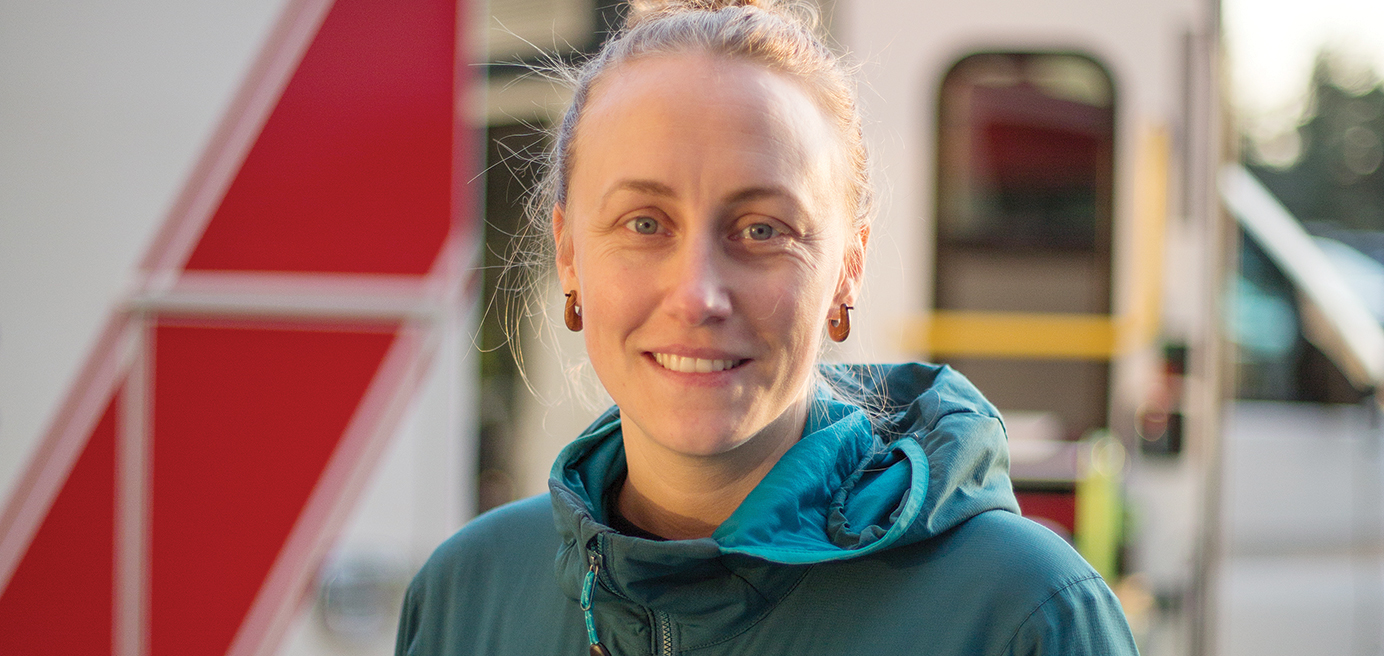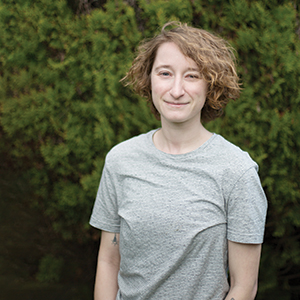 Rising to the Challenge
Rising to the Challenge

MAKING IT WORK Burnaby Hospital's Leisha Marotto says she and her co-workers had to organize their own information and support networks to prepare for the COVID-19 pandemic.
Burnaby Hospital ER nurses demonstrated true leadership qualities during the coronavirus pandemic
Last March, during the early, chaotic days of the coronavirus pandemic – when misinformation about COVID-19 was spreading faster than the disease itself – a group of Burnaby Hospital emergency room nurses decided to examine the available evidence and communicate what they learned to all of their worried co-workers.
"It's easy to forget now," says Philippa Lentz, who began working in the always-busy Burnaby ER in 2016, "but last year, at the beginning of this pandemic, we had no idea what was going to happen next. No one really knew how the virus was transmitted. And all the scary images we were seeing from Italy, New York and other parts of the world were very concerning. It was a really chaotic and uncertain time."
"We went from one spectrum of chaos to another in a very short period of time," adds Leisha Marotto, who has delivered care to ER patients at Burnaby Hospital since 2014. "We basically had to take everything we had been doing in the ER and flip it on its head."
Prior to COVID-19, the facility's emergency room, like ERs around the province, was often overcrowded and understaffed. "We were used to being really busy in the ER," explains Marotto, "with people stacked up on top of one another, with no space for physicians to assess patients and no room for EHS crews to offload patients. We were packed to the absolute brim, especially during flu season.
"And then," she adds, "in the blink of an eye, it all changed. The pandemic landed on our doorstep and we had no idea how to deal with it. There were so many questions and not many answers. We didn't even know what we were supposed to be wearing to protect ourselves and our patients. We were literally preparing for the Apocalypse."
"There was a lot of uncertainty," agrees Lentz. "Many nurses and other staff were honestly concerned for themselves and their patients."
Adding to the confusion was the fact that Fraser Health and other government agencies kept issuing updates, sometimes daily, sometimes hourly, on everything from what personal protective equipment to wear to how many nurses could be in an operating room.
"We were being bombarded with conflicting information and changing policies and procedures," says Marotto. "We had a lot of questions that no one knew the answers to. So, we all looked at each other and decided we'd somehow have to deal with the pandemic, and we'd have to rely on each other. We knew we had to pick up our socks and make this work."
"We were being bombarded with conflicting information and changing policies and procedures."
Lentz and a small group of other ER nurses began meeting in the hospital's cafeteria to discuss how best to deal with the flood of confusing information they were receiving from the health authority. They also searched through all of the hospital's relevant policies and procedures. "We started writing down notes and trying to summarize all of the information we were getting," says Lentz. "Then we just decided to start putting out a daily newsletter and pulling other people in to work on different aspects of it."
The group began calling themselves "The Dukes of COVID."
"I came up with the name as a kind of dumb joke late one night," recalls Lentz, "but people are still using it today." The Burnaby ER nurses began emailing their newsletter with the latest COVID-19 information to all staff.
"The emails were like therapy," say Marotto, adding that most of the newsletter work was done by Lentz and another co-worker, Sarah Bell. "They really, really stepped up. They deserve all of the credit in the world. They were our guiding light and without the two of them we would have drowned for sure.
"They would basically take all the information that we were getting from Fraser Health, summarize it on a daily basis and email it to all staff. Then, when the information would change the next day, they would update us all. It would have been really challenging for us without the Dukes of COVID."
BCNU President Christine Sorensen says the group, like so many other BCNU members across our province, stepped up and helped lead British Columbians through the pandemic.
"These Burnaby Hospital nurses showed true nursing leadership during a time of crisis by ensuring that their co-workers were getting the most up-to-date and accurate information available," she notes. "At a time when much of the country was isolating under public health orders, they continued to put their lives on the line and care for their patients and their co-workers."
In addition to the must-read Dukes of COVID newsletters, the ER team created multiple simulation labs on numerous issues, including intubations, what to do if there was a code in the waiting room and other worst-case scenarios.
"We would talk through the different situations," explains Lentz, "and one of us would take notes, one of us would type up the notes and then we would put it [simulation results] in the newsletter."

COMMUNICATION IS KEY
Philippa Lentz headed up the production of a daily newsletter to keep nurses and other Burnaby Hospital workers informed in absence of information from their employer.
At the height of the first wave of the pandemic last spring, when most types of personal protective equipment were in short supply in BC and around the world, the Burnaby ER nurses began heading to Home Depot and other stores to buy any available protective equipment they could get their hands on. For example, if a nurse learned that some desperately needed N95 respirator masks were still for sale in Langley, someone would jump in their car and drive out to buy them.
Then, the ER nurses' families and friends began to get involved. Marotto's father rummaged through his garage and found nine pairs of safety goggles that were soon being shared by numerous nurses. The goggles, masks and other protective equipment that were in short supply at the hospital were stored in a room the nurses dubbed "The Armoury."
One nurse's mother, who is a seamstress, made and donated over 3,000 scrub caps to Burnaby and other hospitals. Many others in the community donated food or offered their heartfelt thanks to Burnaby Hospital staff for all they were doing in the early days of the pandemic.
"We all pulled each other through this," says Lentz. "When push came to shove, we didn't have a choice. We had to rally for our patients and our co-workers. We had to figure it out. And we did."
"We had to rally for our patients and our co-workers. We had to figure it out. And we did."
"We supported each other emotionally, especially in the early days," agrees Marotto. "It would have been a much worse situation for me if it wasn't for the support of my amazing co-workers."
"A lot of people, including other nurses and doctors, helped out," acknowledges Lentz. "This pandemic has really showed me, in a concrete way, that when a large-scale disaster happens, we need people to stand up and be leaders at every single level. We do need people to take care of the big picture. But we also need people attending to the small details, and they should be properly compensated. It's all of those small details that make up the daily life of the people who actually work in the middle of a disaster." •
UPDATE (Spring 2021)

